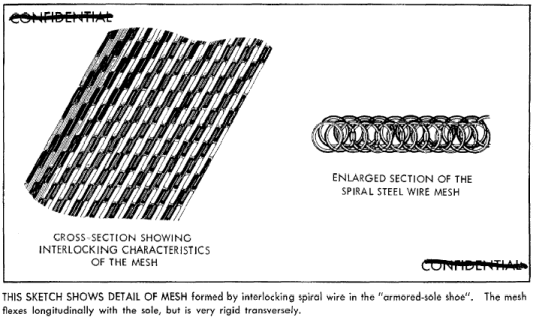 |

|
Related Pages: |
French Develop Shoe With Puncture-Proof Sole To Reduce Foot Casualties in Indochina (1)Article reproduced from US Army INTELLIGENCE REVIEW Number 274, April-May 1954It was designed specifically for use by French and Vietnamese troops in Indochina in an attempt to reduce the number of casualties inflicted by a simple but effective Viet Minh device - a concealed barb or spike-filled board placed across avenues of approach expected to be used by French forces. Bamboo or other hard wood barbs are generally used, but metal spikes may be used. The barbs and spikes are dipped in buffalo dung, debilitating and infectious if its poison enters the body.
Technologists testing the shoe were able to hammer nails through the sole and mesh only by exerting considerable force. In penetrating the mesh, the nails seemed to rotate; when removed, they appeared to have been threaded. Since the barb and spikes used by the Viet Minh are firmly attached to their support, they cannot rotate sufficiently to penetrate the dense wire mesh of the shoe. The antipuncture principle developed for this shoe may have additional military application for defense against antipersonnel mines, This item is currently under study by United States Army technologists. (a)
Original article notes:(1) Article prepared by the Intelligence Branch, Office of the Quartermaster General, US Army. [back](2) See photographs and sketches on pages 45-47. [back] Additional notes:(a) Few if any of these protective boots appear to have been issued before the end of the conflict. Military bureaucracies being much the same the world over, it is interesting to note that although this boot was under study by the US Army as early as 1954, development of a slip-in protective insole was only begun in October 1961 when it was "discovered" that the Viet Cong used sharp poisoned stakes in ground traps. Only much later was the spike protection mesh made an integral component of the boot. [back]Source:
|

 Soldiers
who pierce their feet on these sharp-pointed objects reportedly are out
of action from four to six months. The armored-sole shoe is ankle-height
and similar in construction to a tennis shoe. It has a cleated-type sole
and heel made of black vulcanized natural rubber. A layer of one-eighth-inch
thick spiral steel wire mesh is imbedded in the plane surface (not in the
cleats) of the rubber sole. This mesh flexes with the sole when it is bent
longitudinally, but it is very rigid transversely. The upper portion of
the shoe is of heavy olive drab duck with an unbleached drill lining. The
shoe also has a removable insole of compressed rubber and cloth trimming
waste, with a burlap cover and a cotton tape-bound edge, There are nine
large eyelets on each side of the closure; the laces are extra long and
are made of olive drab cotton. The shoe is manufactured in France.
Soldiers
who pierce their feet on these sharp-pointed objects reportedly are out
of action from four to six months. The armored-sole shoe is ankle-height
and similar in construction to a tennis shoe. It has a cleated-type sole
and heel made of black vulcanized natural rubber. A layer of one-eighth-inch
thick spiral steel wire mesh is imbedded in the plane surface (not in the
cleats) of the rubber sole. This mesh flexes with the sole when it is bent
longitudinally, but it is very rigid transversely. The upper portion of
the shoe is of heavy olive drab duck with an unbleached drill lining. The
shoe also has a removable insole of compressed rubber and cloth trimming
waste, with a burlap cover and a cotton tape-bound edge, There are nine
large eyelets on each side of the closure; the laces are extra long and
are made of olive drab cotton. The shoe is manufactured in France.